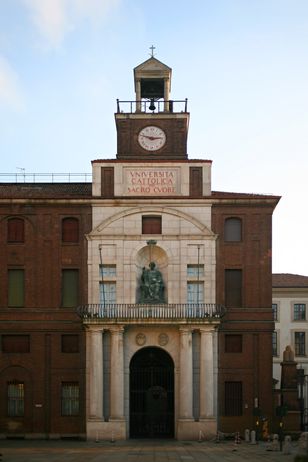

The Catholic University of the Sacred Heart is considered one of the most prestigious private universities in Italy, and for certain fields of study, such as medicine, education, linguistic sciences and foreign literature, perhaps it is even unparalleled. It is the largest private university in Europe and is the largest Catholic University in the world.
The university was founded in 1921 by Agostino Gemelli, a Franciscan friar, physician and psychologist and was inaugurated in front of Archbishop of Milan, Achille Ratti, who several months later was elected as Pope Pius XI. The first classrooms were located in Palazzo del Canonica on via Sant'Agnese and there were only two fields of study: philosophy and social sciences. In 1930 the institution was moved to the ancient 8th century Benedictine monastery, which had been part of the Basilica of St Ambrose. The monastery had also been enlarged a year earlier by architect Giovanni Muzio, who concentrated on giving the facade a pristine aspect. Today it is the seat of the university's main campus. There were 68 students in the university's first year; today there are over 40,000. In 1924 the Humanities and Law Departments were added to the Cattolica, as it is known among Italians. After World War II, in 1947m the School of Political, Economical and Business Sciences was inaugurated.
With time the university opened departments in other parts of Italy. Today there are campuses in five different cities: Milan, Rome, Brescia, also in the Lombardy region, Piacenza in the Emilia Romagna region and Campobasso in the Molise region. Milan houses the School of Mathematics, Physics and Natural Sciences, the School of Banking, Finance and Insurance Sciences, the School of Foreign Languages, Literature and Foreign Literature and the School of Psychology. Rome boasts the renowned School of Medicine; Piacenza the School of Agriculture; Brescia the School of Teaching and Education; Campobasso also the School of Medicine and Surgery.
As most historical buildings in the center of Milan, the university suffered a great deal during the American bombings in 1943, including its famous 15th century Bramante cloister. German officers, while searching for documents about Italian resistance fighters, found fifty skeletons in the basement, which dated back to the 16th century and most likely belonged to plague victims. The destruction, however, did not discourage Father Gemelli, who after the war said that his university would "rise again more beautiful and bigger than before."
In 1968 student riots broke out on the Milan campus due to the increase in tuition fees. First the students occupied the university and when the police chased them out, they marched to the Archbishop's residence. The following day the protests spread to every university in Italy. Consequently, the Cattolica closed for several months.
Being one of the most prestigious universities in Italy, the Cattolica obviously has a limited number of seats and requires an admission test to enroll. There are usually about 30 candidates for one student seat. The School of Medicine in Rome is the most difficult to be admitted to.
The University's most famous alumni were and are: former Italian president Oscar Luigi Scalfaro, former Italian Prime Minister and EU President Romano Prodi, founder of the ENI energy company, Enrico Mattei, fashion designer Nicola Trussardi, current Milanese Archbishop Angelo Scola and famous singer Roberto Vecchioni.
Unfortunately, the Catholic University of the Sacred Heart's international ranking is not as illustrious as its history or alumni. The three top university ranking agencies give it a rank of 450-451 out of all the world upper education institutions. But no one really takes all these statistics to heart.